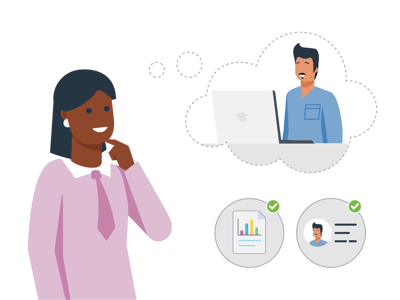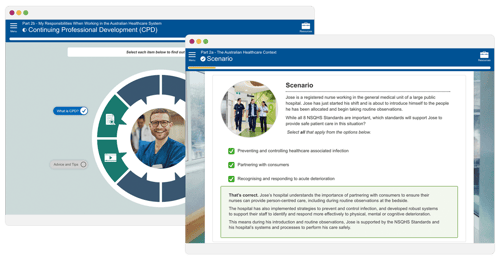Scenario-based learning (SBL) is a powerful and engaging learning approach used successfully to upskill and develop workforces across a range of industries. But perhaps nowhere do clinical scenarios play as central of a role as in the healthcare industry.
Over the past few years clinical training, especially in the tertiary sector, has been revolutionised by the introduction of virtual and augmented reality into the classroom. The benefits of using VR and AR are many, including being cost-effective, standardised and — notably — safe.
There are, however, limits to the application of VR in healthcare workplace learning, where the standardisation and large cohorts of a university course is replaced by the need for workplace-specific and personalised programs.
So how can workplace training be made engaging, realistic, and safe without the use of VR? The answer is well written clinical scenarios.

What is scenario-based learning and how does it work?
Scenario-based learning, as the name suggests, applies realistic scenarios to train learners in an authentic environment. Whether applied online or in face-to-face training, key benefits of SBL include; memory and retention aid (as the example scenario mirrors their everyday experiences in the workplace), the ability to seamlessly apply learning in their day-to-day tasks, the mental and physical safety to try and fail without serious consequences, and the opportunity to go back and try alternative approaches to problem-solving.

A well-developed scenario acts as an authentic simulation of an encounter that would normally only be possible in real-world clinical work. Early exposure to the kinds of questions and issues that can arise in the field will let learners practice their responses without the stress usually associated with a real-life clinical situation.
Tips for creating strong clinical scenarios
 Know what you’re looking to achieve
Know what you’re looking to achieve
As with all learning design, knowing the behavioural changes you are looking to achieve and the problems you want to solve is crucial to your learning initiatives being successful.
For any scenario you design, consider questions like:
-
What key behavioural changes do I want to see in my learners/staff?
-
What skills or knowledge do I want them to have acquired upon completion of the learning experience?
-
How will I know if the program has been successful?
 Understand your learners
Understand your learners
Having a clear idea of who your learners are is key to making learning that keeps them engaged and answers the key question of ‘what’s in it for me’.
Spending some time designing ‘learner personas’, that is, a representation of your typical learner/team members will help ensure that the scenarios you chose are authentic and relevant. It will also guide you in your use of language and terminology to ensure that no learner is left behind.
Taking some time to consider where and when your staff will be consuming your learning program will also help you determine how your scenarios are presented. Are they long or short, presented in writing, as video or audio? Are summative assessment quizzes likely to engage and drive completion, or will staff find them stressful and do better with reflective, non-assessed questions?
 Make the scenarios as authentic as possible
Make the scenarios as authentic as possible
We have all had the experience of sitting through learning, either at school or in the workplace, thinking “How is this relevant to me?”. Unfortunately, there is a ton of workplace training out there that not only fails to engage with the individual but might even miss the mark with a whole industry.
In an industry like healthcare, where training is continuous and ranges from clinical training to workplace policies to equipment handling, there is always a risk that some parts of the learner group feel less of an alignment with the content. But there is no reason that generic workplace upskilling, such as diversity training, communication upskilling, or leadership development training, should contain scenarios that are not authentic to the industry where they are implemented. This is especially true for the healthcare sector which has unique requirements in multiple areas.
For example, a personal care worker in an aged care facility undertaking training in bullying and harassment is much more likely to engage with a scenario that is familiar to them. For example, where the hostile party is a resident and the scenario is played out in a care family dining room, rather than an out-of-the-box program where the aggressive party is a CEO and the setting is a board room, even if the takeaway (e.g. ‘report bullying to your HR team’) is the same.
 Don’t forget to tell a story
Don’t forget to tell a story
One of the key strengths of SBL is that a good scenario can evoke feelings through the use of engaging storytelling. As our brains are wired to remember stories — and particularly emotional stories — better than random facts, SBL is a powerful tool through driving engagement, learner investment and content retention.
In an area like compliance training, this can be realised by creating an avatar with whom your typical learner can identify, e.g. a nurse or a care assistant, and place them in the situation you wish to introduce your learners to, or test their understanding of. If your online authoring tool and platforms allow, you might even consider multiple pathways — a kind of ‘choose your adventure’ style design where the selections a learner makes throughout the program determines where they end up in the end; just like in the real world.
If you are curious about how adaptive, personalised learning could help support your organisation, book a time with one of our Learning Solutions Consultants here.


